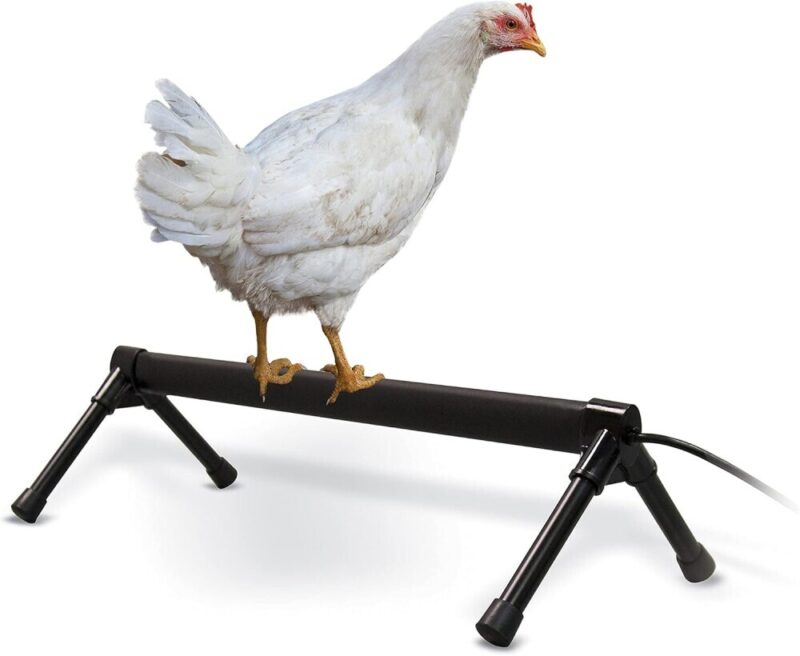
Are you looking to live off the grid or cut down on energy bills? How will you keep your chickens comfortable? Keeping your chickens warm without electricity is totally doable and can even be fun! Here’s how.
First, a side note:
Chickens acclimate very well as the cold weather comes on. Molting in autumn ensures your chickens have the warm winter feathers they need to weather the cold. It has to get very cold to turn on a heater in the coop, which is what I’m driving at, so please don’t heat your coops unless necessary.
First, solar energy is a fantastic alternative. Solar panels can be hooked to small heaters or DIY thermal boxes.
A pricey but efficient means of keeping a cozy coop is to use a solar panel to charge a generator that charges a heated roost in your coop. It looks like this:


These don’t just keep the coop warm but are also a step towards sustainable living. If sunlight is limited, storing heat with thermal mass might be your best bet.
Materials like concrete, bricks, or water containers can absorb warmth during the day and release it at night, ensuring your feathered friends remain cozy. Use dark poly water containers to absorb more heat, and a freeze won’t find you picking up shattered glass.
Another genius trick involves incorporating natural insulation. Stuffing the coop walls with straw or hay traps heat inside. Think of it like adding a snug winter coat to their home. Earth berming, or building part of the coop into the ground, can also provide excellent insulation using the earth’s natural warmth.
How about hay bales around the outside base of the coop? This can help, but you will increase your mouse population when the little ones find the comfort and protection of those bales. This is something to consider.
Finally, don’t forget about the power of body heat. Keeping chickens close together boosts their collective warmth. Make sure there’s enough space so they’re not overcrowded. Using roosting bars or perches lets them snuggle up and share body heat more effectively.
If there is too much room in the coop for the chickens to keep warm, hay bales inside the coop can reduce the space to be heated while providing new perches for your birds. They also provide something of interest to help keep your chickens occupied during the long winter months.
Ensuring Your Chickens Stay Warm in Freezing Temperatures
Chickens are tougher than they look and have some natural defenses against the cold.
Their feathers provide great insulation, but that doesn’t mean you can leave them to fend for themselves in freezing temperatures. Proper insulation of your coop is key. Lining the walls with materials like straw, hay, or even old blankets can make a world of difference in keeping the cold air out and the warm air in.
Another effective method is to create windbreaks around the coop. Bales of straw, wooden boards, or even tall shrubs can block freezing winds from reaching your chickens. This simple barrier can drastically reduce wind chill and keep your coop more comfortable.
Bedding is more than just a place for chickens to sleep. Using deep litter bedding, where you build up layers of straw or wood shavings over time, generates heat through natural decomposition and provides insulation from the cold ground. Remember to keep it dry to prevent mold and maintain cleanliness.
My coop is 8×8 feet square. In three seasons, I keep a bag or two of shavings down so my chickens aren’t on the bare floor. In winter, three or four bags help provide insulation and a little warmth from decomposition. Coop cleaning is more of a chore, but my birds are happy.
Finally, positioning your coop wisely can help. Please place it in a sunny spot to maximize solar gain during the day. Also, keeping it off the ground, perhaps on a raised platform, can prevent the cold from seeping in from below. These small tweaks can transform your coop into a cozy haven, even when the temperatures plummet.
Preventing Water from Freezing Without Electricity
Keeping your chickens’ water from freezing in the dead of winter can be a real challenge, especially if you’re trying to avoid electricity. A bit of ingenuity and some clever techniques can help you keep that water flowing.
One effective method is to use insulated water containers. These can keep water from freezing for much longer periods. Wrapping the waterers in materials like bubble wrap or old blankets adds an extra layer of protection against the cold. You can even find purpose-built insulated chicken waterers designed specifically for this task.
Another neat trick involves placing containers on thermal mass. Remember those concrete or brick bits from your coop heating strategy? You can use the same principle here. During the day, they absorb heat from the sun and release it around the water containers as temperatures drop. This simple method keeps the water liquid longer into the night.
Geothermal energy might sound fancy, but it’s super practical. Digging down a bit and placing your water container in the ground takes advantage of the earth’s natural warmth, which can be warmer than freezing air temperatures. This is a major undertaking.
You can’t just dig a hole in the circumference of your waterer. How would the chickens reach it? You must dig beneath the frost line to ensure your water will not freeze. This only works if you have a dirt floor, of course, and the depth is at least 44 inches.
For a genuinely old-school approach, a Ping-Pong ball or two floating in the water can work wonders. The movement created by the small breezes chickens make can help stop ice from forming on the surface. Another option is a black rubber tub; it absorbs sunlight better than lighter colors, helping the water stay warmer during the day.
How Cold is Too Cold for Chickens? Understanding the Thresholds
Chickens can handle cold weather better than you’d expect, but there’s a limit to their resilience. Knowing when it’s too cold is crucial for their well-being.
First, keep an eye on their behavior. If the flock huddles together continually or appears lethargic, it’s a sign they’re struggling with the cold. Frostbite on combs and wattles is a red flag, too. Pay attention to these signs and act quickly to provide extra warmth.
Cold resistance varies by breed. Some breeds, like the Rhode Island Red and Plymouth Rock, are more cold-hardy, whereas others, such as the Leghorn, are less equipped for freezing temperatures. Understanding your chickens’ breed-specific needs can help you better prepare for cold snaps.
Remember that large combs and wattles are more susceptible to frostbite than compact ones. To avoid frostbite, look for breeds with smaller features.
Next, ensure your chickens’ diet supports their energy needs during cold spells. Increasing their corn intake can boost body heat since digesting corn generates warmth. A protein-rich treat before bedtime can also help them maintain body temperature throughout the night.
Emergency measures might be necessary during extreme cold. This could include temporarily moving chickens to a garage or basement or using temporary shelters like tarps or tents to block icy winds more effectively. Consider these emergency options and be prepared to act swiftly if the temperatures become dangerously low.
How do you keep your chickens warm when it’s dangerously cold?
Dave

Chickenmethod.com

